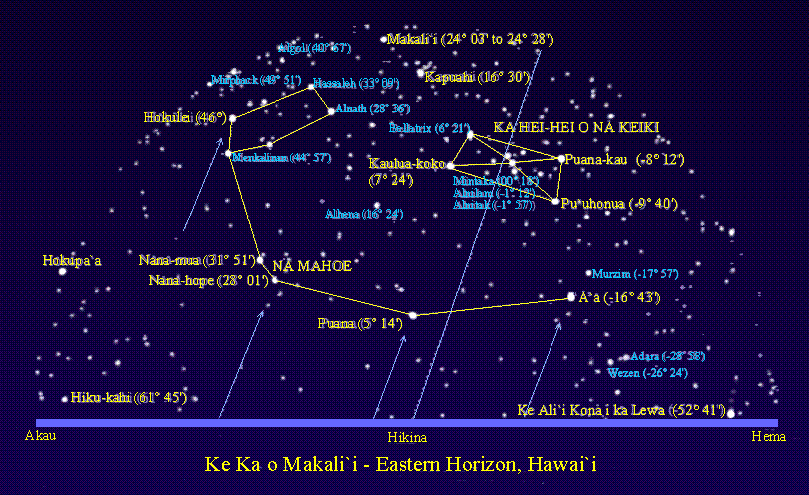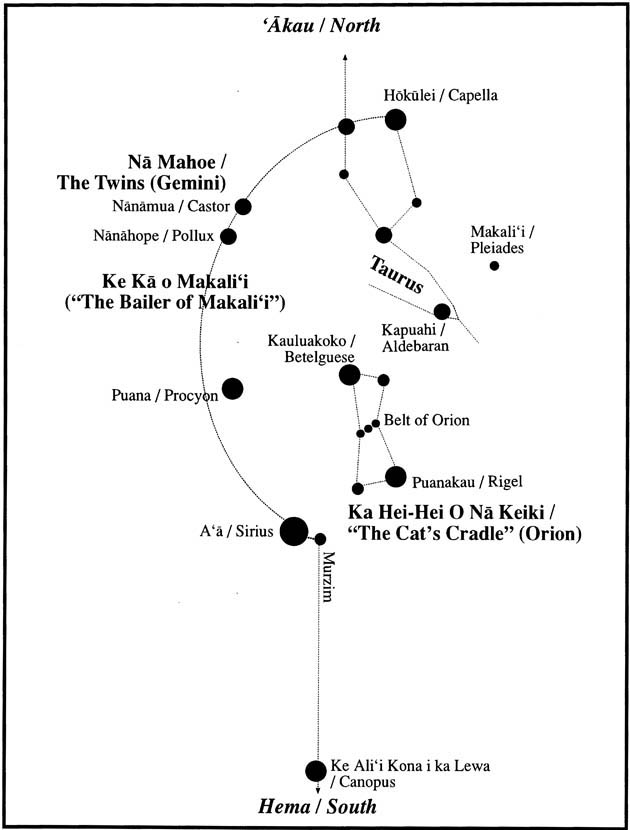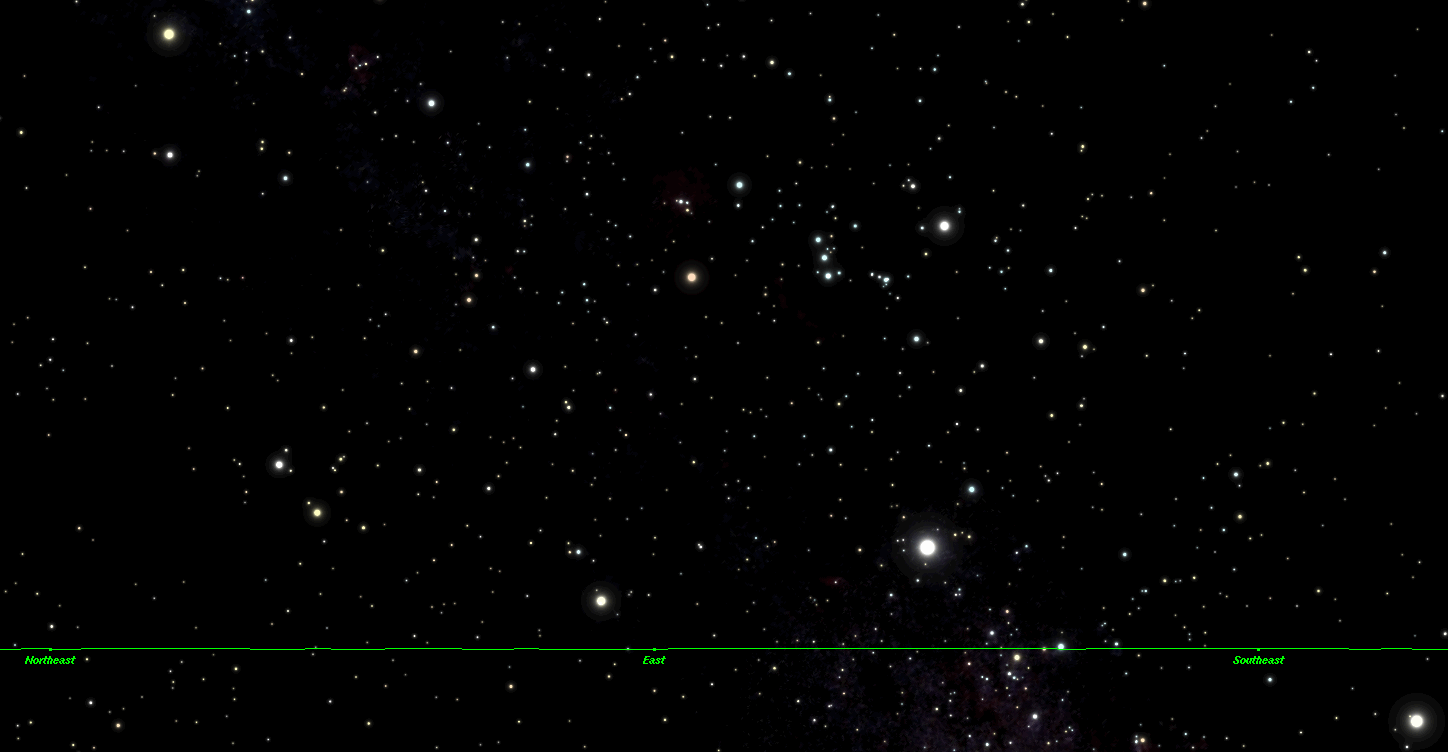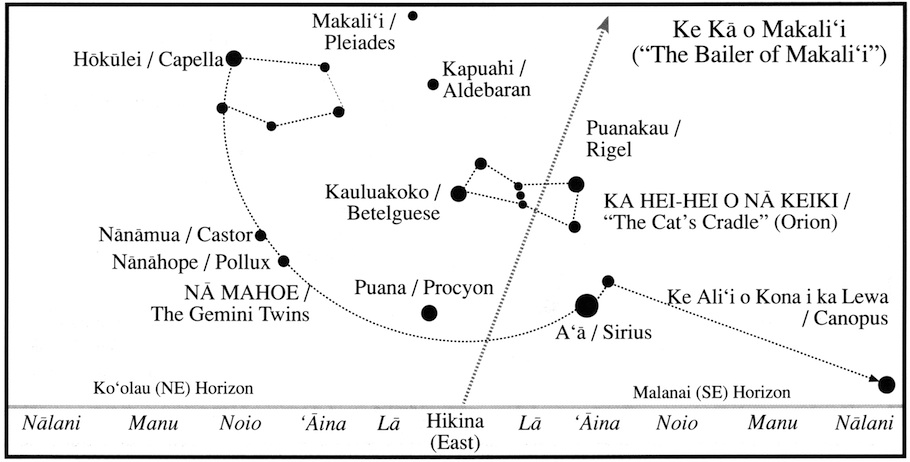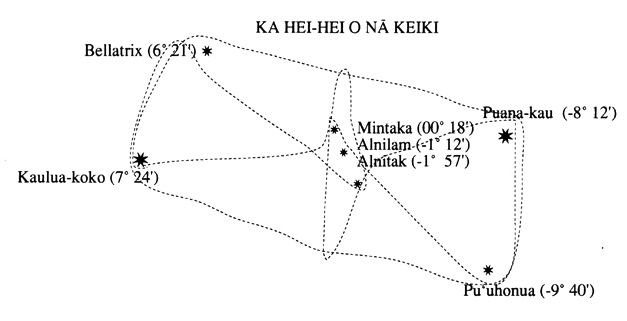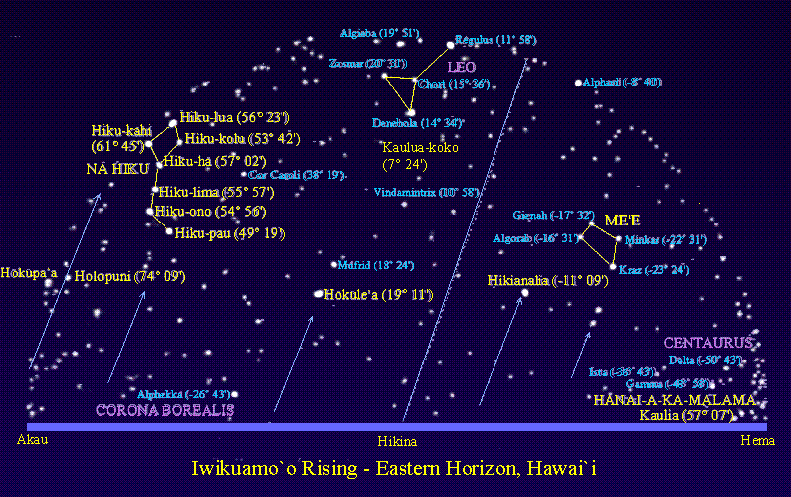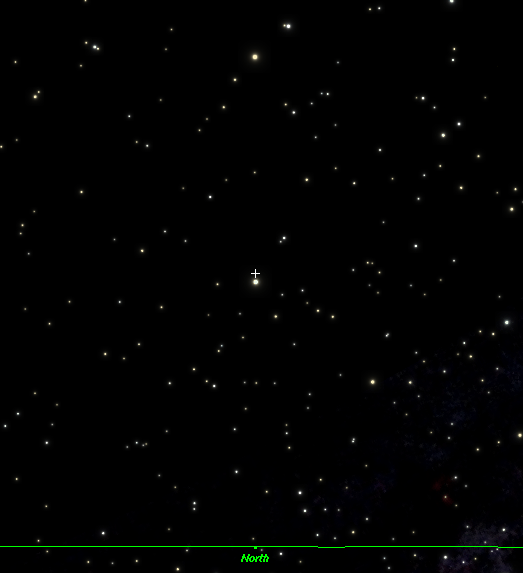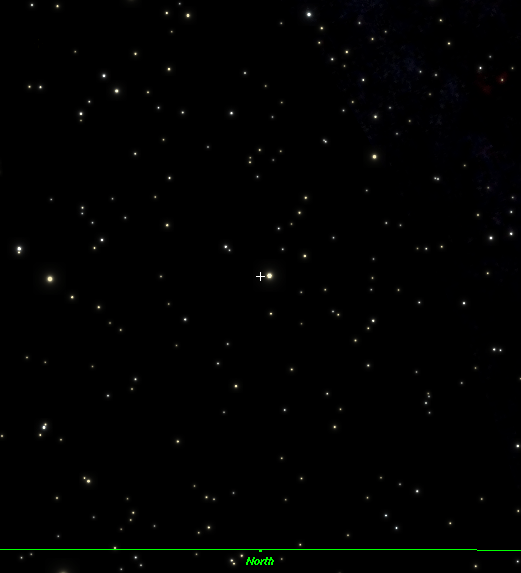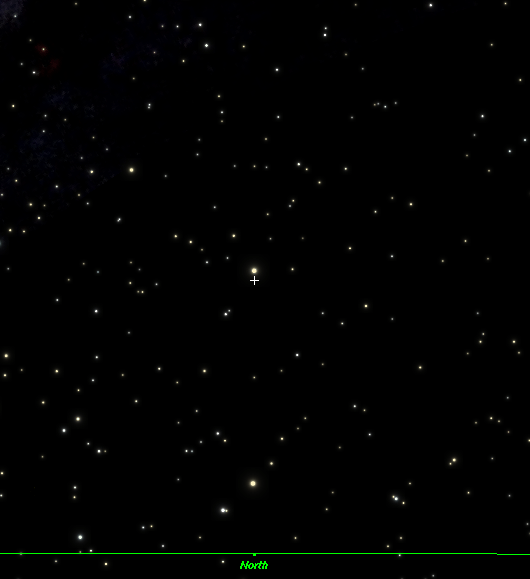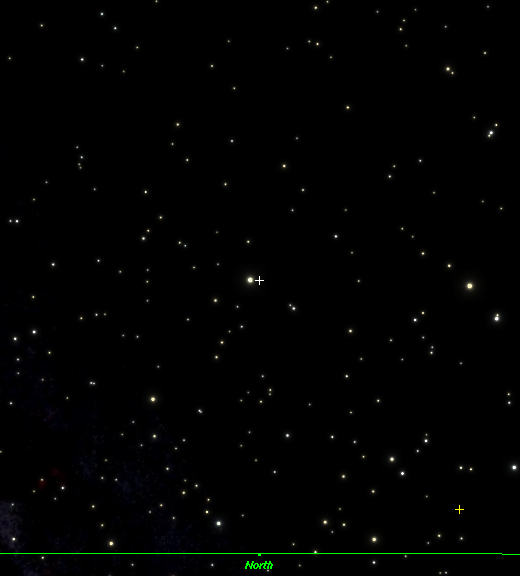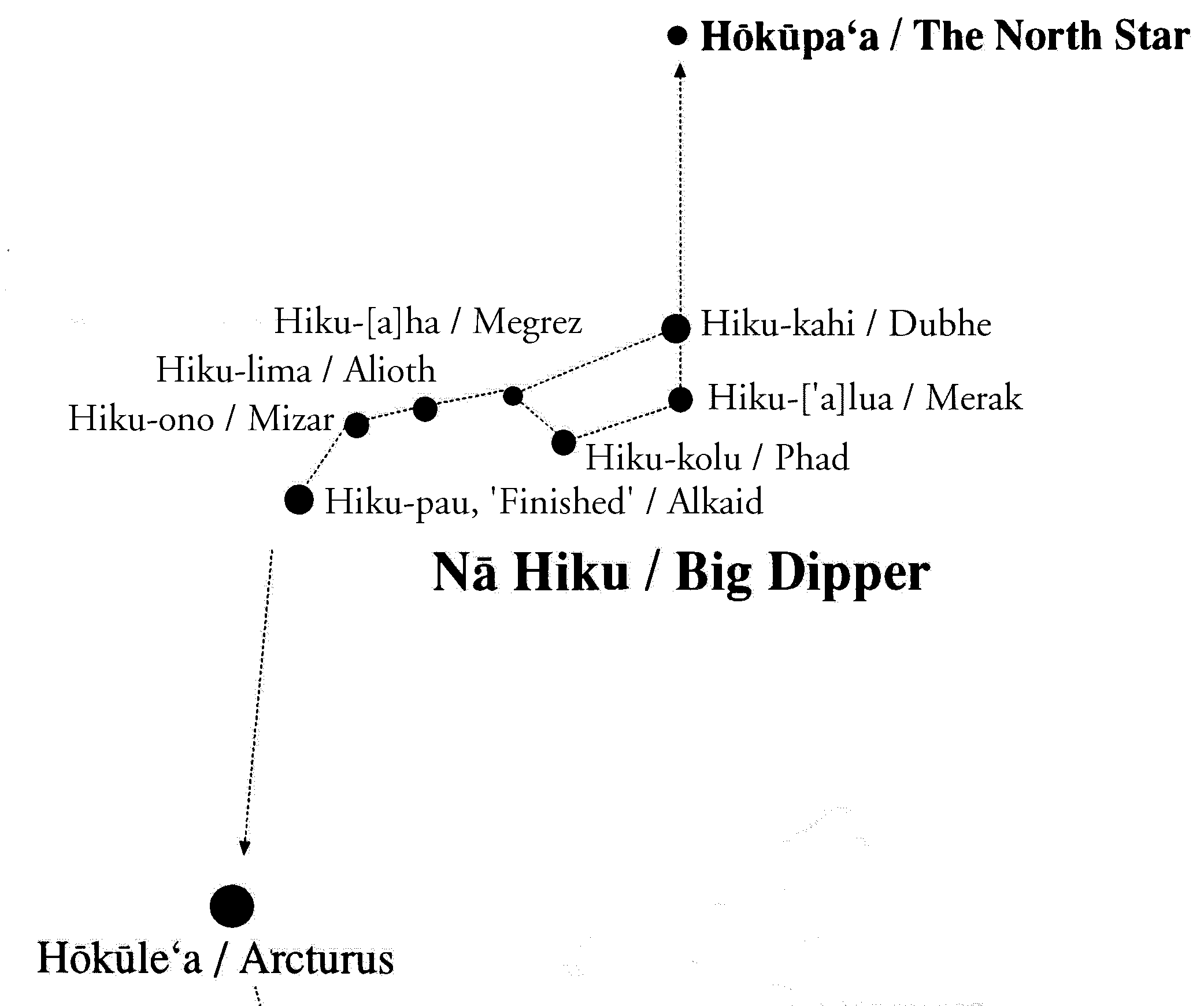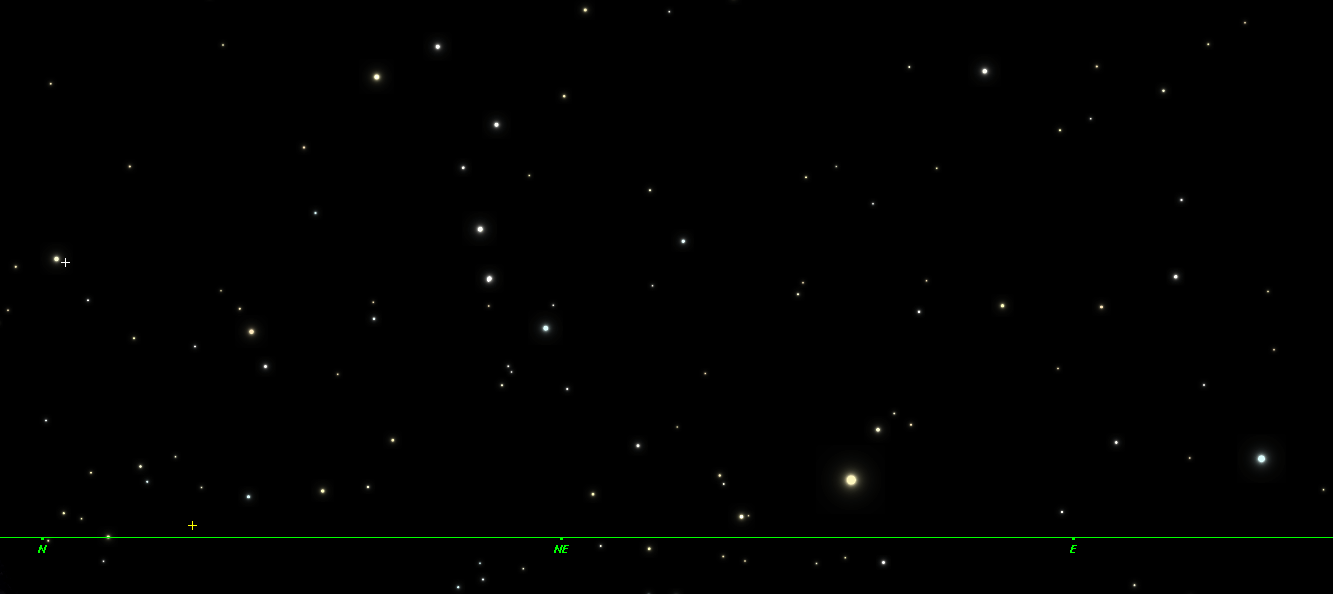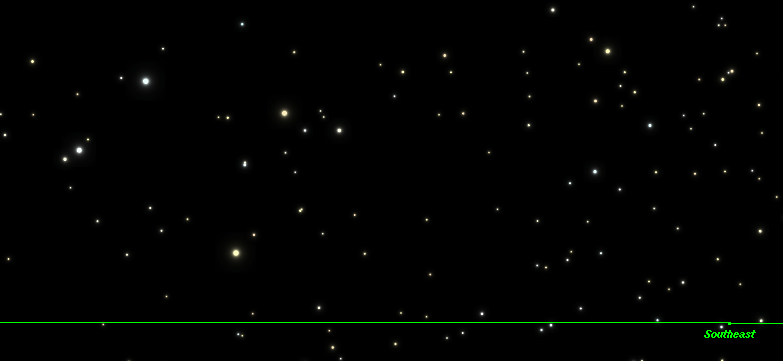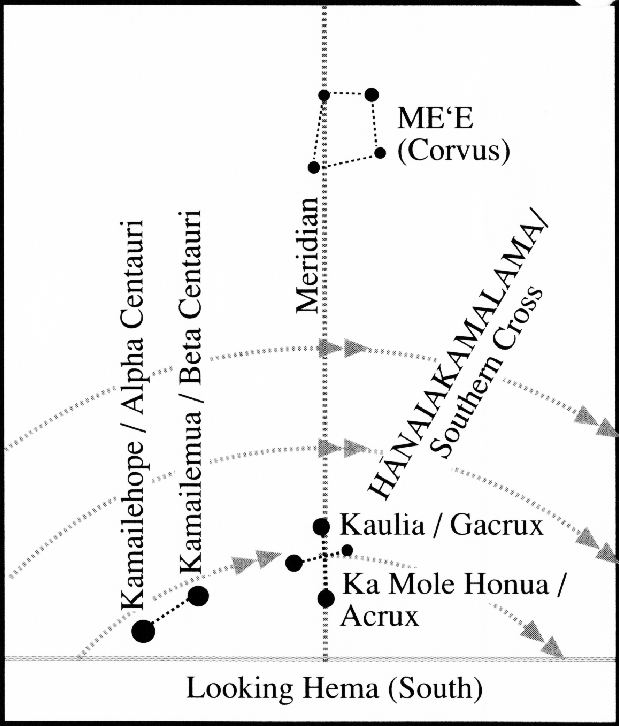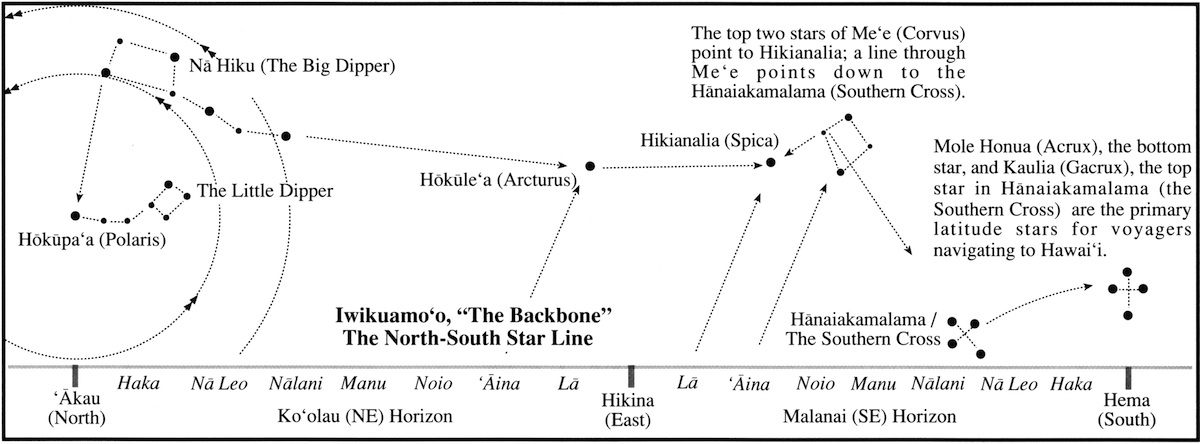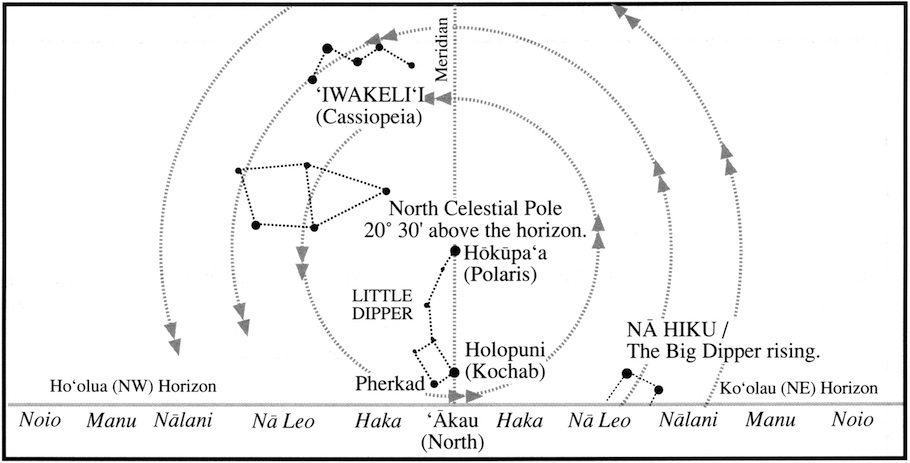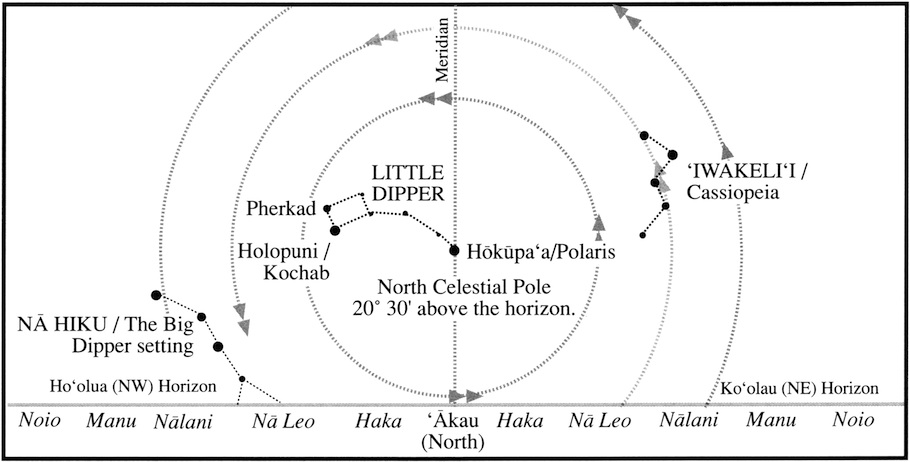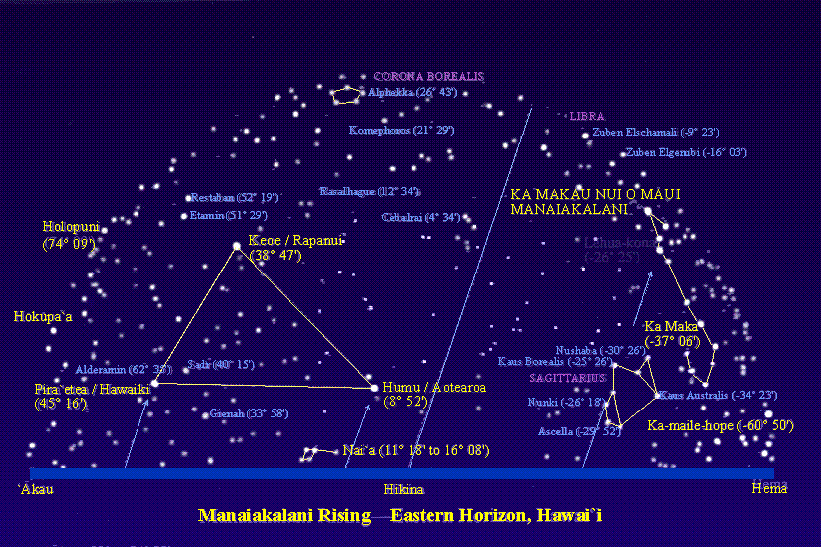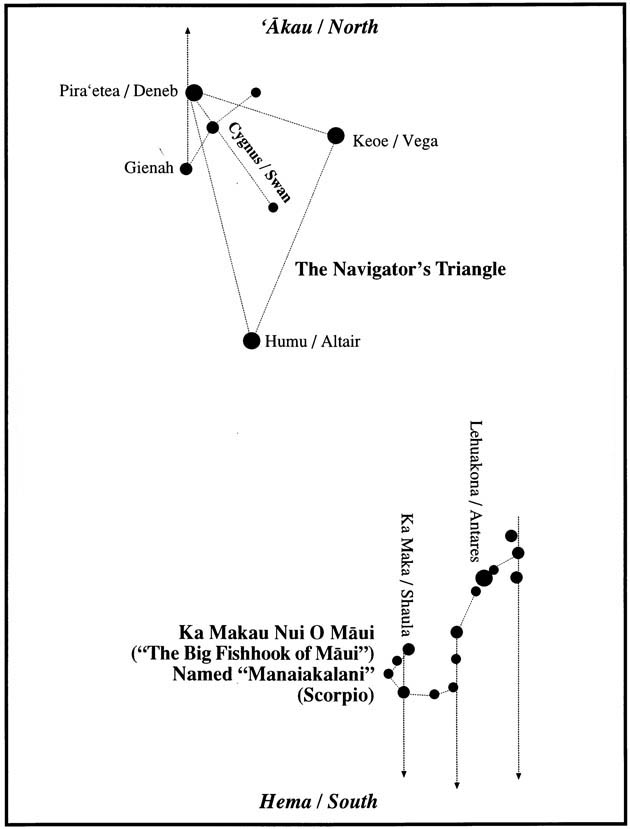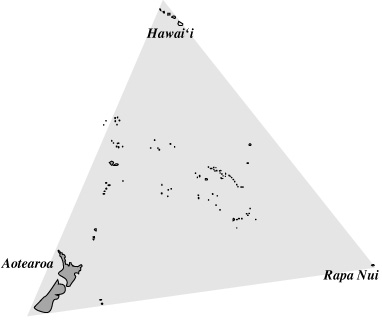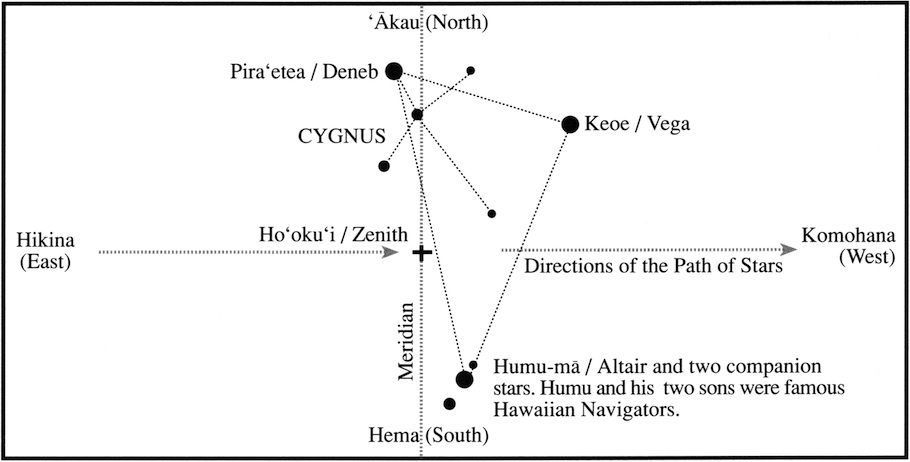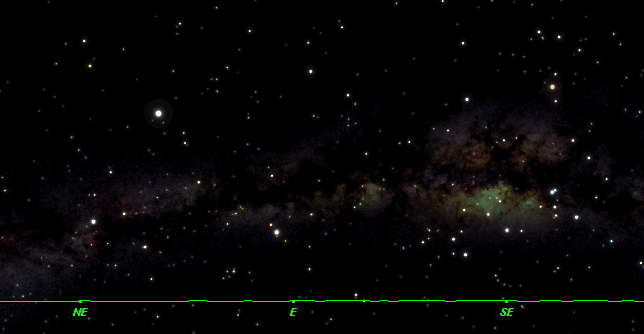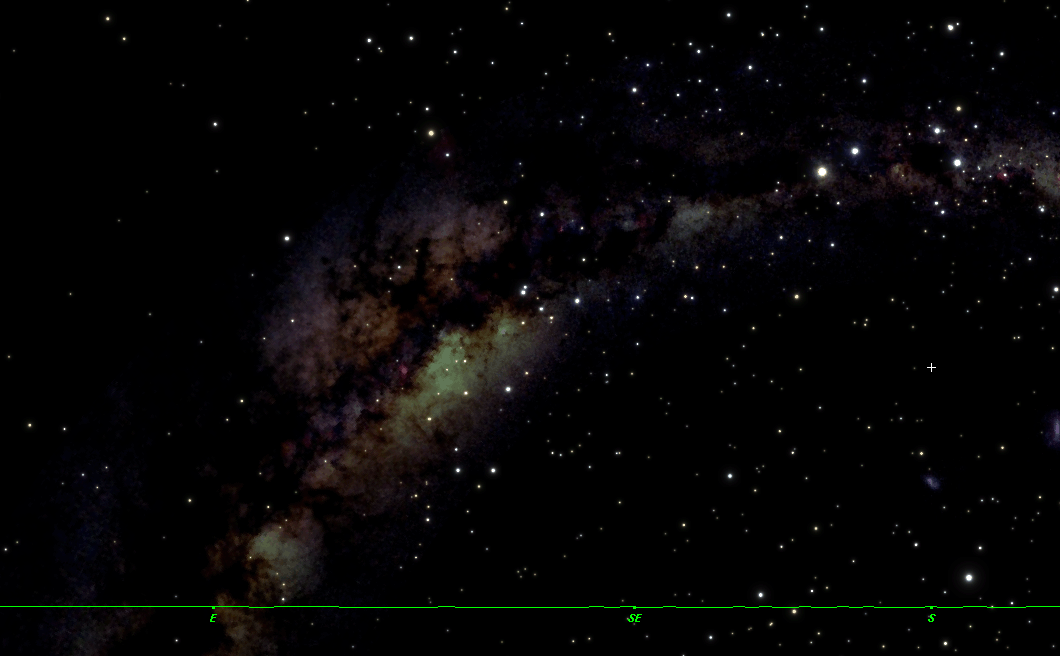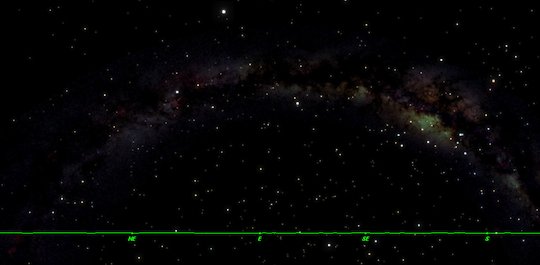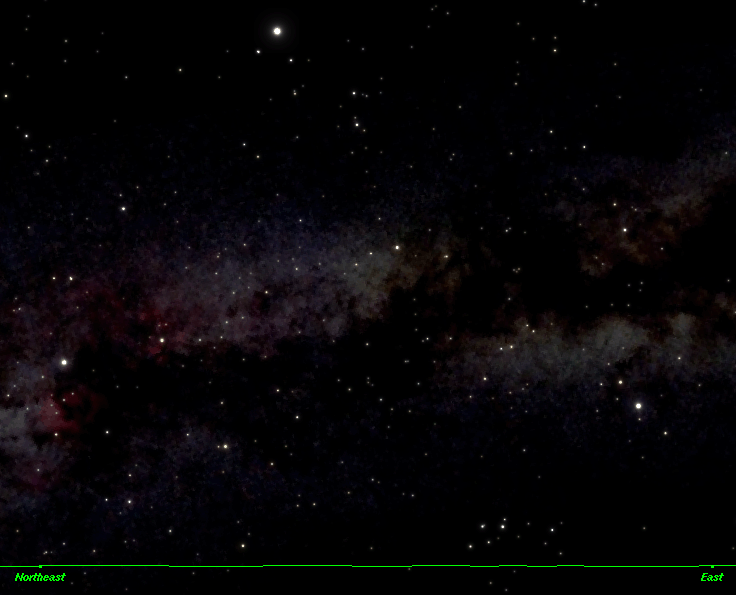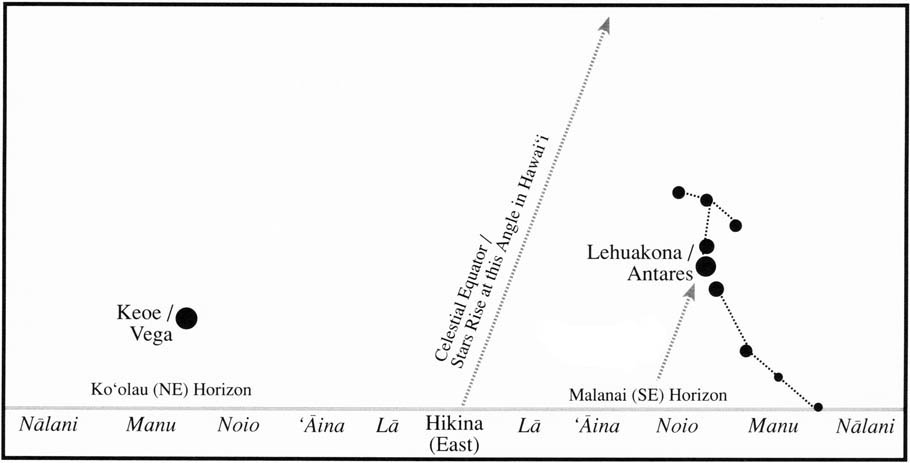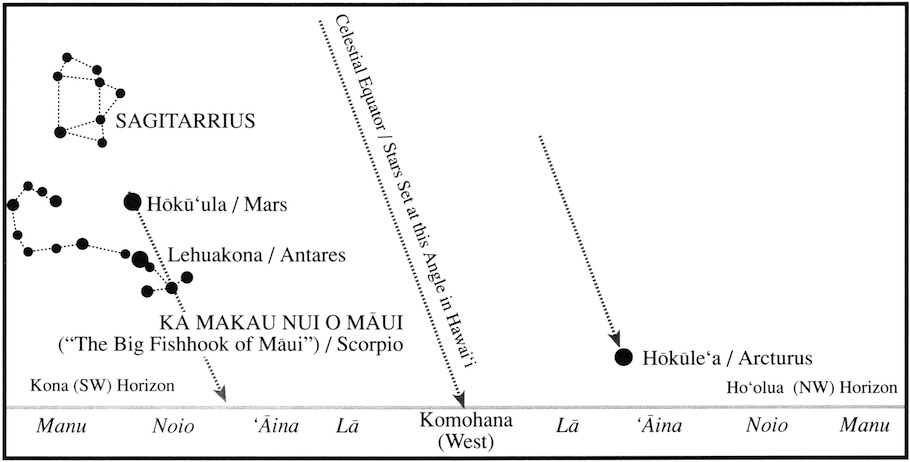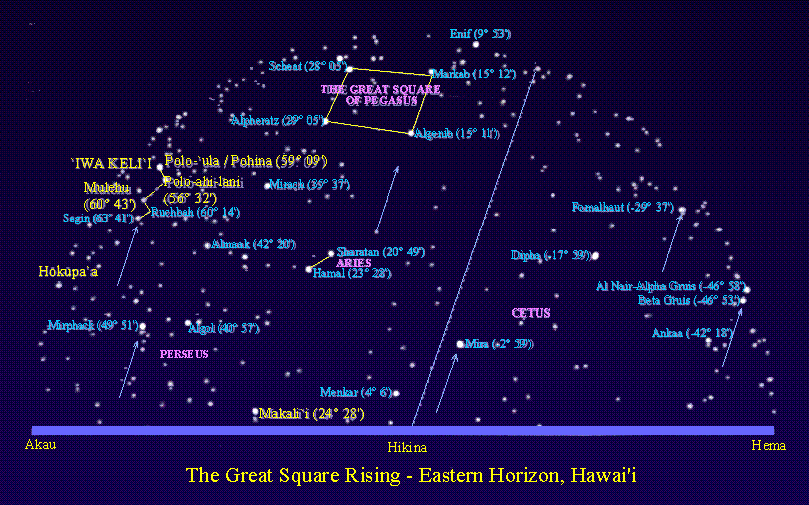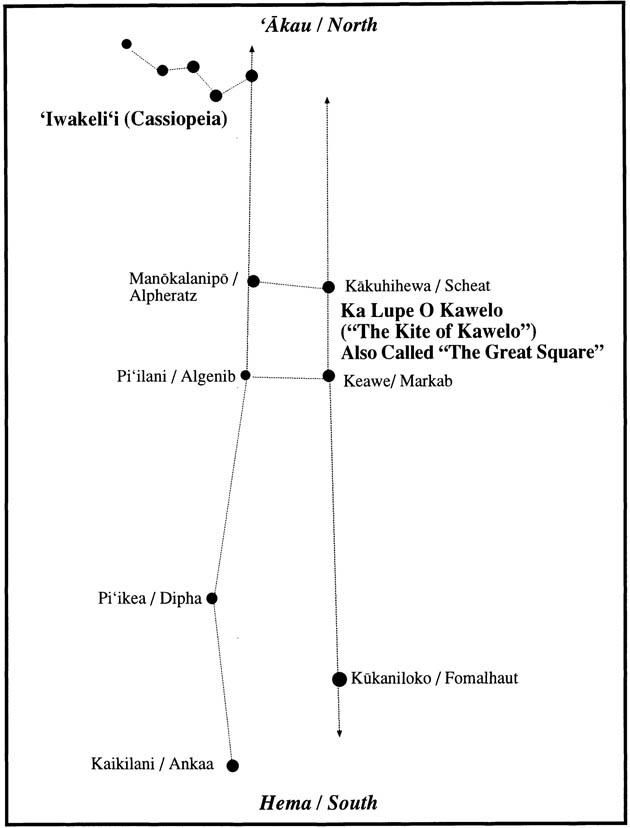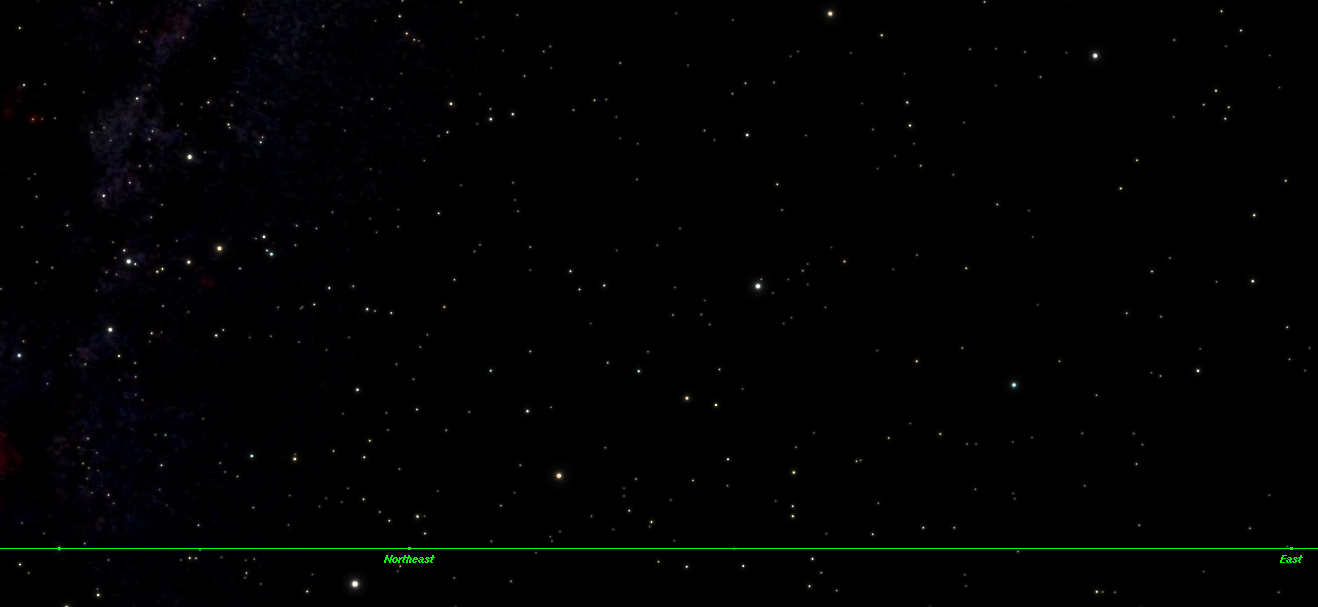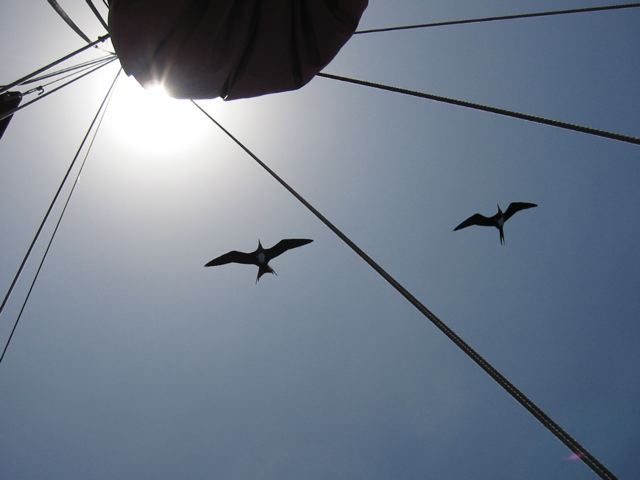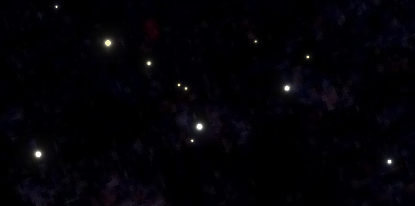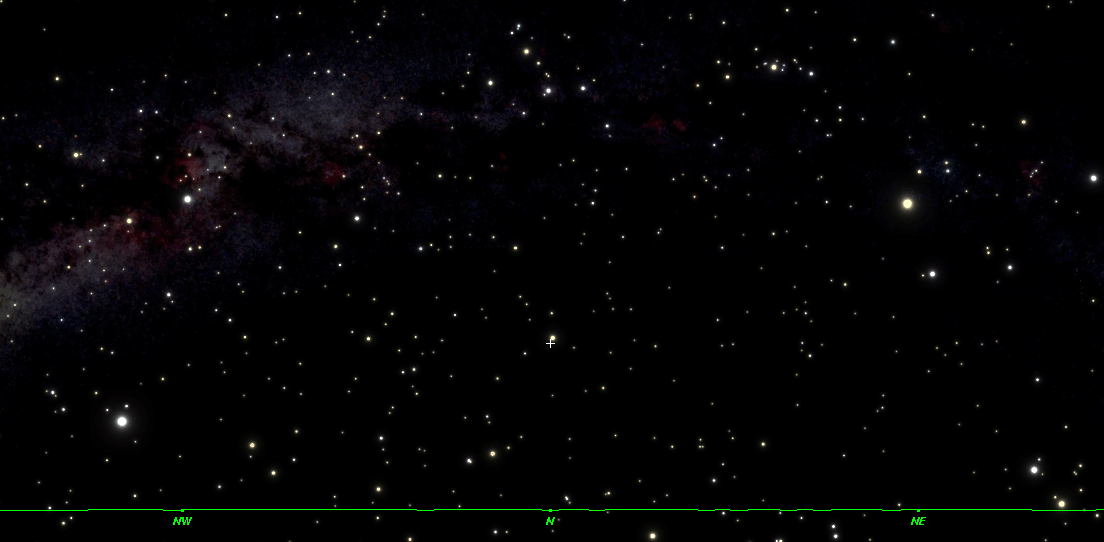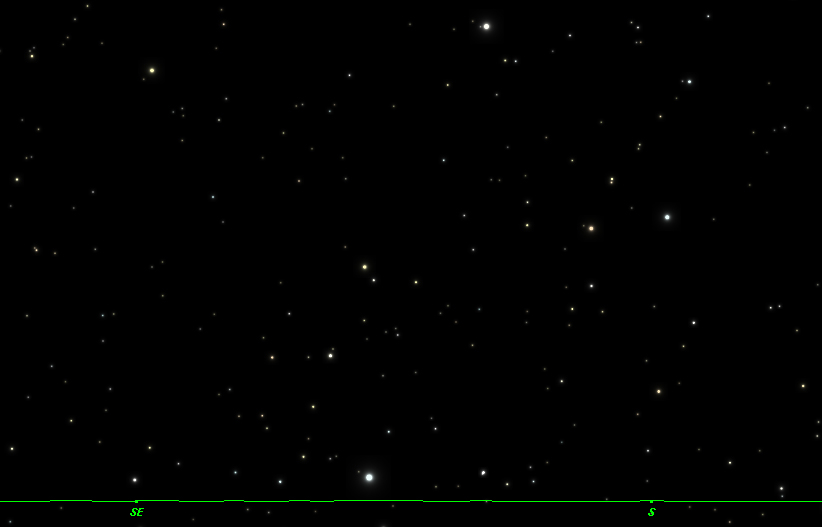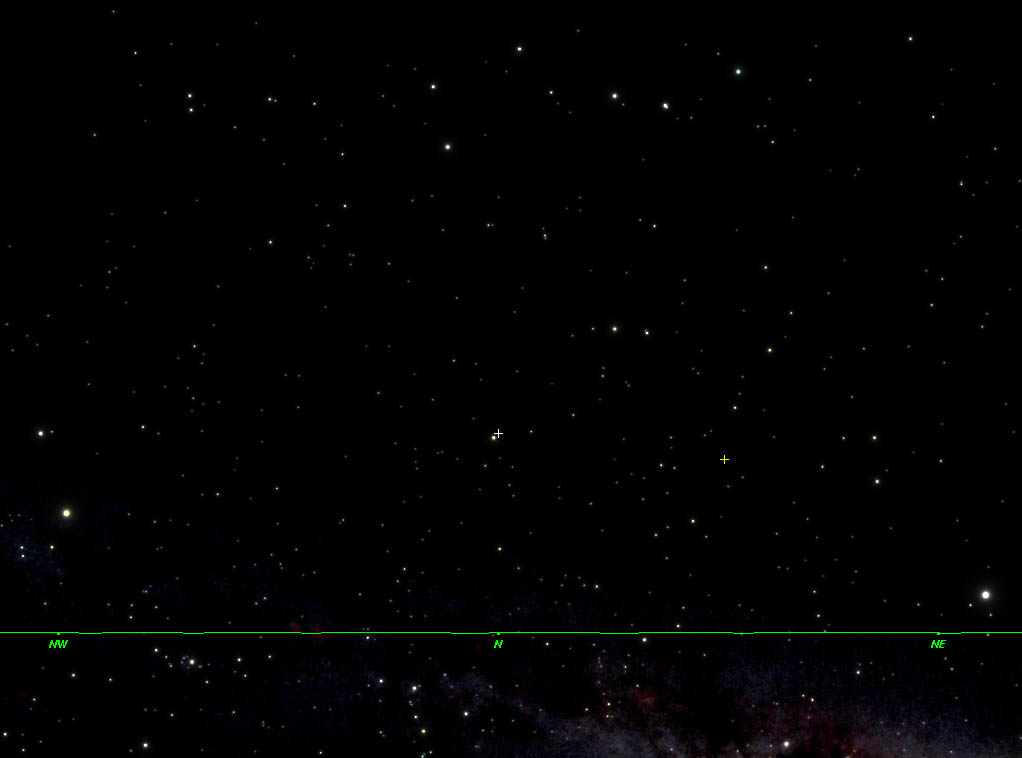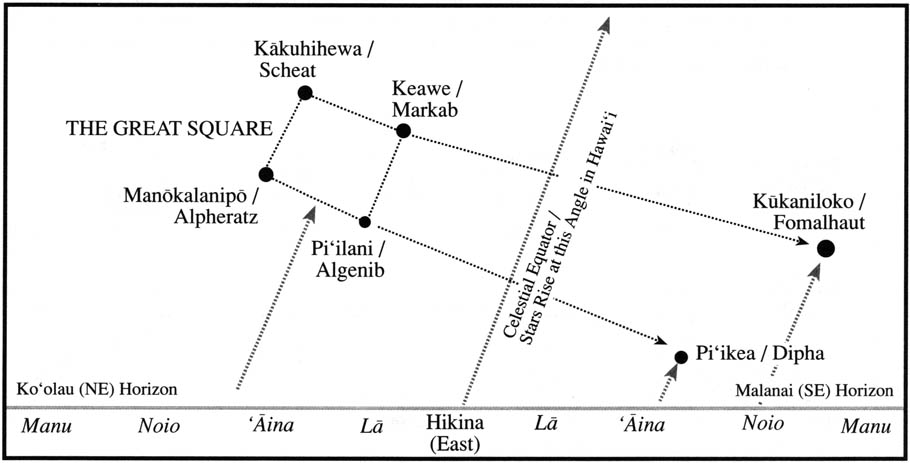Hawaiian Star Lines and Names for Stars
Note: The night sky charts below that extend to the left and right margins of the text may be larger than they appear in this html file. You can view the larger charts by dragging the images from the browser onto your desktop, then opening them with graphic-viewing software. For print versions of the night-sky charts that would use less toner , you can use the Invert function in a graphic program like Photoshop (Image>Adjustments>Invert) to reverse the image (i.e., create a chart with a white sky and dark stars).
The wayfinder memorizes the position of stars on the celestial sphere in order to use them as directional clues when they rise and set. On cloudy nights, when only parts of the sky are visible, he may recognize isolated stars or star groups and imagine the rest of the celestial sphere around them.
To help remember the pattern of stars in the sky, Nainoa Thompson has organized the sky into four star lines, each line taking up about one fourth of the celestial sphere:
- Ke Ka o Makali‘i (“The Canoe-Bailer of Makali‘i”)
- Iwikuamo‘o (“Backbone”)
- Manaiakalani (“The Chief’s Fishline”)
- Ka Lupe o Kawelo (“The Kite of Kawelo”)
One way to remember the sequence of the four quadrants of the sky is to remember it geometrically :
1. a curve (Ke Ka, “The Canoe-Bailer”); followed by 2. a line (Iwikuamo’o, sometimes called the “North-South Star Line”); followed by 3. a triangle (Manaiakalani contains the three bright stars of the Navigator’s Triangle); followed by 4. a square (the fourth quarter of the sky includes the Great Square of Pegasus).
Or the line can be remembered as a sequence of objects:
1. a bowl or bailer (Ke Ka); followed by 2. a backbone (Iwikuamo’o); followed by 3. a fishhook (Manaiakalani is the name of Māui’s fishhook); followed by 4. a kite (Ka Lupe).
The star lines appear one after another in the sky. For more charts depicting these star lines rising and setting, see “Star Lines Rising and Setting”.)
Star Line 1. Ke Kā o Makali‘i (“The Canoe-Bailer of Makali‘i”)
Ke Kā o Makali‘i is formed by five stars curving across the sky from ‘akau (north) to hema (south) in the shape of a bailer. It rises in the east like a cup, holding the constellation of Orion and Taurus, and as it begins to set in the west, it pours the content of the cup down to the western horizon.
During Ho’oilo (the winter season from November to April), these stars are visible for most of the night in the Hawaiian sky; during Kau (the summer season from May to October), these stars are in the sky overhead mostly during the daylight hours.
The five stars of Ke Ka o Makali‘i are the following:
Hoku-lei (“Star-Wreath”): This sun-yellow star is at the ‘akau end of Ke Ka o Makali‘i. According to Makemson, Hokulei is also the name for a circle of five stars forming a star-lei, the star Hokulei being the brightest star in the lei. The Western name for Hokulei, the star, is Capella (Alpha Aurigae); the name of the constellation that includes the circle of five stars is Auriga (“Charioteer”). According to Johnson and Mahelona, Hokulei is an “unidentified star, lit., ‘star-suspended over land'” (5).
Na Mahoe (“The Twins”) is a pair of stars. The first of the pair to appear in the Hawaiian sky, a whitish green star, is called Nana-mua (“Look forward”); the sun yellow star that follows is called Nana-hope (“Look behind”). Johnson-Mahelona and Makemson give the name as “Nana,” equivalent to “Ana,” or star, so “Nana-mua” means “First star” and “Nana-hope” means “Last star.” The pair of stars is also called Nana-mua-ma (“Nana-mua and associate”). Other Hawaiian names: Mahau (“Twins”-M), [Ka-]Mahana (“Twins”), Na Hoku-Mahana, and Na-lalani-a-Pili-lua (“The lines of the clinging ones”-J & M). The Western name for this pair is Gemini (“The Twins”); Nanamua is called Castor (Alpha Geminorum) and Nanahope Pollux (Beta Geminorum).
Puana (“Blossom”; a new Hawaiian name based on a Maori name): This light yellow star has no recorded Hawaiian name; in Maori it is called Puanga-hori (“False Puanga”) to distinguish it from its pair Puanga or Puanga-rua (“Blossom-cluster”), or Rigel. The Western name for Puana is Procyon (Alpha Canis Minoris).
‘A‘a (“Burning brightly”): This blue-white star, the brightest in the sky, is at the hema point of Ke Ka o Makali‘i. Johnson and Mahelona suggest ‘A’a is also a name for the seabird known as the booby (52), which is used to locate islands; these birds leave their nesting island in the morning to hunt for fish at sea, and return to the island in the evening (range: 30-50 miles-Lewis 171). Other names for this star: Hiki-kau-[e]-lia; Hiki-kau-e-lono (cf. A-iki-kau-e-lono, “The-small-booby-bird-of-Lono”-J & M); Hiki-kau-lono-meha (“Star of solitary Lono”; also Lono or Lono-meha); [Hiki] kaulana-o-meha; Kau-ano-meha (“Standing alone and sacred”-M); Hoku-kau’opae (“Star for placing shrimp”-J & M; cf. Kau-opae: “name for Sirius as patron of shrimp fishing”-M); [Hoku-ho’okele-wa’a” (“Canoe-guiding star”-J & M); Kaulu-lena, Kaulua-lena (“Yellow star”), or Lena; Kaulua[-i-ha’i-mohai] or [-a-ha’i-mohai] (“Flower of the heavens”-M). Makemson says Kaulua means “Bright star”; Kaulua is also the name of a month: February on Hawai‘i, June on Moloka’i, and December on O’ahu. The Western name for this star is Sirius (Alpha Canis Majoris).
The navigator looks east for rising stars to use as clues to direction. In the graphic below, Ke Ka o Makali‘i is rising. The brightest star in the sky, ‘A‘a (Sirius) is to the right of center, rising between east and southeast. To the right of SE and still below the horizon line is Ke Ali‘i Kona i ka Lewa (Canopus).
To the left ‘A‘a, but at a little lower altitude is Puana (“Blossom”)/Procyon. To the left of Puana and higher than it is Na Mahoe (The Twins), between E and NE. Above the twins, near the top of the chart above NW, is Hokulei (Capella) the brightest star in the constellation Hokulei (Auriga).
Above ‘A‘a is Ka Hei-hei o Na Keiki (Orion), in the middle of which are he three stars in a line, called Na Kao, The Darts (Orion’s Belt) with two pairs of stars, one pair on each side of the belt. Na Kao rose due east, but has angled off to the south, now appearing between east and southeast. (See “The Celestial Sphere” for an explanation of this angle of rising in Hawai‘i.)
Makali‘i (“Little eyes” or “Little stars”): This cluster of seven little stars rises ahead of the stars of Ke Ka o Makali‘i. According to Makemson, “Maka-li’i” may be interpreted as “High-born stars” (“Maka-Ali‘i”); Beckwith (367) suggests “Eyes of the chief,” Makali‘i being the ho’okele (navigator-steersman) for the famous voyager Hawai‘iloa.
Makali‘i was the “guiding star [cluster] for the first month of the year (November-December); also marked the beginning of the year when it rose at sunset. A thousand years ago, the rising of this group of stars in the east would have occurred a month earlier (October-November).”
Makali‘i was the name of a month (December on Hawai‘i, April on Moloka’i, October on O’ahu-Malo 33). Other names for Makali‘i: Hu[i]hui (“Group”); Kupuku (“Cluster”). Beckwith says that Makali‘i was actually Hoku’ula (Aldebaran), and the cluster of seven stars called Makali‘i had the following names: Na-Huihui-o-Makali‘i (“The Cluster of Makali‘i”), Huihui-koko-a-Makali‘i-kau-i-luna (“Makali‘i’s rainbow colored nets hung above”), Na Wahine-o-Makali‘i (“The wife of Makali‘i”), Na-ka-o-Makali‘i (“The bailers of Makali‘i”), Na-koko-a-Makali‘i (“The nets of Makali‘i”). According to Makemson, Makali‘i is the bow of the Maori canoe Tainui, with the Cross as the anchor, “the Belt of Orion as stern, the Sword as cable, and the Hyades [the face of Taurus] as sail [Te Ra-o-Tainui]” (249). The cluster of seven stars is called the Pleiades in the west.
Hoku’ula (“Red star”) or Kapuahi (“Sacred fire”): This giant red star appears after Makali‘i and Hokulei in the Hawaiian sky. Other Hawaiian names include ‘Au-kele-nui-a-iku (a legendary hero, “the seeker of the water-of-life, grandson of the mo’o Mo’oinanea, who gave him three magic objects with which to achieve his goals on a long sea journey of forty days”-Johnson and Mahelona, ix; see Fornander, Vol. 4, 32-111, for a version of the legend of ‘Au-kele-nui-a-iku); Kao-ma’aiku; Kao. The Western name for this star is Aldebaran (Alpha Tauri).
Ka Hei-hei o na Keiki (“The Cat’s Cradle of the Children”; a new Hawaiian name): The constellation Ka Hei-Hei o na Keiki was named for its resemblance to a string figure (hei-hei) made by children. This constellation has two bright star pairs separated by a row of three stars. In the West, the two pairs are the points of the shoulders and knees of Orion; the row of three stars is Orion’s belt.
The string figure which the configuration of stars most closely resembles goes by the names of “hoku” (“star”), “spider,” or “kohe ekemu” (“embrace me”), a continuation of the figure “po” (“night,” which represents a starry night and allows the player to make the stars appear, as in the evening, and disappear, as at dawn). Both figures, “hoku” and “po,” were made on all the Hawaiian islands. “Spider” is an appropriate name since this figure travels along the celestial equator, which was called Ke Alanui o Ke Ku’uku’u, or “The Roadway of the Spider”: Mintaka, one of the three middle stars in this constellation, with a declination of 00 18,’ rises almost due east (0°) and ‘sets almost due west travelling along the celestial equator.
(For instructions on how to make “po” and “hoku” (“star”) or “spider,” as well as the chants that go along with the two figures, see Lyle A. Dickey, String Figures from Hawaii (Honolulu: Bishop Museum, 1928, pp. 78-80).
Kao-Makali‘i, Na Kao (“The Darts of Makali‘i”): The three stars in the middle of Ka Hei-hei o na Keiki. In Tonga, the three stars are seen as three canoe paddlers (Kyselka 48). In Kiribati (Gilbert Islands) the three are seen as three fishermen. The Western names for the three stars are Mintaka (Delta Orionis), Alnilam (Epsilon Orionis), and Alnitak (Zeta Orionis).
Kauluakoko (“Brilliant red star”; “koko” means “blood; rainbow-hued”): This red star is at the lower-left corner of Ka Hei-hei o na Keiki as it rises. Other Hawaiian names for this star: Ka’elo (the name of a month: January on Hawai‘i, May on Moloka’i, November on O’ahu, and June on Kaua‘i-Malo); ‘Aua; Hoku-‘ula (“Red star”); Koko; Melemele (Name of an ancestral homeland in the north-J & M). The name for this star in the West is Betelgeuse (Alpha Orionis).
Pu’uhonua (the City of Refuge at Honaunau on the Big Island, a new Hawaiian name, punning on the Arabic name “Saiph”/”safe”): This star is the lower-right corner star of Ka Hei-hei o na Keik as it rises. The Greek name is Kappa Orionis.
Puana-kau (“Suspended Blossom”-Makemson): This blue-white star, “suspended” above Ke Ka o Makali‘i, is the upper-right corner star of Ka Hei-hei o na Keiki as it rises. The name for this star in the West is Rigel (Beta Orionis).
Ke Ali‘i o kona i ka lewa (“The chief of the southern heavens”-Johnson and Mahelona): This bright blue-white star, the second brightest in the sky, appears south of ‘A’a. The house of Nalani on the Star Compass was named for it. Its Western name is Canopus (Alpha Carinae).
The chart above depicts Ka Hei Hei rising in the east. The three stars at its center, known as Na Kao, the darts (i.e., the Belt of Orion), are to the right of east. The highest of the three and the first to rise, Mintaka, rose due east, but the stars are angling 21 degrees to the south in Honolulu, along the celestial equator, and thus, it no longer appears directly above east. The four bright corner stars of this constellation surround the Darts, two on each side. The bright red star Kauluakoko (Betelgeuse) is at the bottom left corner. The star above it is Bellatrix (no Hawaiian name); going clockwise around the corners, the bright star on the other side of the darts from Kaulaukoko is Puana-kau (Rigel), while the star at the bottom right corner is Pu‘uhonua (Saiph). High about Kauluakoko is Kapuahi (Aldebaran) and to the left of Kapuhai is the pentagram of star called Hokulei, with its brightest star, also called Hokulei (Capella).
Declinations of stars in Ke Ka o Makali‘i (Hawaiian Name / English Name / Declination/ House on the Hawaiian Star Compass):
- Makali‘i (Pleiades): + 24° (‘Aina)
- Kapuahi (Aldebaran): + 16° (La)
Ka Hei-hei o Na Keiki (“The Cat’s Cradle”/ Orion)
- Kauluakoko (Betelguese): + 7° (La)
- Mintaka in Belt of Orion 0° (Hikina-Komohana)
- Puanakau (Rigel) – 8° (La)
- Hokulei (Capella) + 46 ° (Manu)
Na Mahoe (Gemini)
- Nanamua (Castor) + 32° (Noio)
- Nanahope (Pollux) + 28° (Noio)
- Puana (Procyon) + 5° (Hikina-Komohana)
- A’a (Sirius) – 17° (‘Aina)
- Ke Ali‘i Kona i ka Lewa (Canopus): – 53° (Nalani)
Star Line 2. Iwikuamo‘o (“Backbone”)
Iwikuamo‘o (“Backbone”) runs from Hoku-pa’a (the North Star) at the North Celestial Pole (NCP) to Hanai-a-ka-malama (the Southern Cross) near the South Celestial Pole (SCP). (See “The Celestial Sphere” for an explanation of the NCP and SCP.) The stars in the line are, metaphorically, vertebrae along a backbone. Iwikuamo‘o (lit. “Bone back-lizard”) is also a metaphor for a genealogical line, with each vertebra representing a generation. This star line follows Ke Ka o Makali‘i into the sky.
Two stars in Na Hiku (Big Dipper) point to Hokupa‘a, the North Star. The curve of the handle points to Hokule‘a (Artcturus). The two stars on the narrow side of Me‘e (Corvus) point to Hikianalia (Spica). And a north-south line between the stars of Me‘e (Corvus) point south to Hanaiakamalama (The Southern Cross). Na Kuhikuhi (The Pointers) point forward to Hanaiakamalama.
The stars in this line, starting in the north, are as follows:
Hokupa’a (“Fixed star”): This circumpolar star, which does not rise or set in the Hawaiian sky, appears “fixed” near the NCP, with other stars circling around it. Actually it is inscribing a circle 1.8 degrees wide around the pole, and because of precession, the wobbling of earth on its axis, Hoku-pa’a is not actually “fixed” permanently. A circle of precession is completed in 26,000 years, and in 13,000 years the north pole will point to the opposite side of the circle of precession, between Hawaiki (Deneb) and Rapanui (Vega) and Hoku-pa’a will appear to be circling the NCP (Kyselka and Lanterman 24-8).
In our era, the Hawaiian names for this star suggest its stationary appearance: Noho-loa (“Eternal”), Kumau (“Standing Perpendicularly”), Kio-pa’a/Kio-pa (“Fixed projection”), Kia-pa’akai (Biblical: “Pillar of salt”), Maka-holo-wa’a (“Sailing-canoe eye”-Johnson & Mahelona, or “Star of the sailing canoe”-Makemson). The name for this star in the West is Polaris (Alpha Ursae Minoris).
Holopuni (“To circle”; “To sail or travel around”; a new Hawaiian name); also, Hoku-Mau (in honor of Mau Piailug, the Satawalese navigator who taught non-instrument navigation to Hawaiian navigators); in Hawaiian, “mau” means “constant,” “perpetual,” “always”). This star appears to circle perpetually around Hoku-pa’a. The name for this star in the West is Kochab (Beta Ursae Minoris).
Hokupa‘a and Holopuni are the two brightest stars in the sky around the NCP (marked by a white cross in the charts below). Hokupa‘a is near the NCP, less than a degree away. The sequence of four charts below show Holopuni in four positions as it circles Hokupa‘a, which itself inscribes a much smaller circle around the NCP. Holopuni’s journey around Hokupa‘a takes 24 hours, one rotation of the earth. In the four charts, the bright star that appears to accompany Holopuni on its journey around Hokupa‘a is Pherkad:
1. Hokupa‘a appears a just below the NCP (marked by +). Holopuni is directly above Hokupa‘a near the top of the chart. Pherkad is above Holopuni, to the right.
2. Six hours later, Hokupa‘a has now circled just to the right of the NCP. Holopuni has circled to the left (west). Pherkad is farther away and higher up than Holopuni, near the left edge of the chart.
3. Six hours later, Hokupa‘a has circled just above the NCP. Holopuni has circled directly below Hokupa‘a, above the horizon, with Pherkad lower and to the left.
4. Six hours later, Hokupa‘a has circled just to the left of the NCP. Holopuni has circled to the right, with Pherkad lower and farther away, near the right edge of the chart.
Na Hiku (The Seven; Big Dipper): This constellation of seven stars moves around Hoku-pa’a farther out than Holopuni. “Donaghho gives the full name as Na Hiku-ka-Huihui-a-Makalii, the Cluster-of-the-Seven-of-Makalii. The stars of Na Hiku are individually designated by numbers: Hiku-kahi [“Seven-one” / Dubhe], Hiku-[‘a]lua [“Seven-two” /Merak], Hiku-kolu [“Seven-three” /Phad], Hiku-[a]ha [“Seven-four” /Megrez], Hiku-lima [“Seven-five” /Alioth], Hiku-ono [“Seven-six” /Mizar], and Hiku-pau [“Seven-‘Finished” /Alkaid] (Beckwith, The Kumulipo: A Hawaiian Creation Chant 208).
Hiku-kahi and Hiku-[‘a]lua point north toward Hokupa‘a. The last three stars, Hiku-lima, Hiku-ono and Hiku-pau, curve toward Hokule‘a.
The front stars of Na Hiku point to Hokupa‘a, the North Star
In the chart below, Na Hiku is rising above NE. A box is created by four bright stars (the dipper). Hikukahi is the brightest star in the box, at its top-left corner. Going clockwise, the box is completed by Hikulua (the highest star in the box), Hikukolu and Hikuha (the dimmest of the seven stars). In this rising configuration of Na Hiku, a handle or tail formed by three stars, Hikulima, Hikuono, and Hikupau, extends downward; the handle points to Hokule‘a (Arcturus), the brightest star in the northern sky, rising near the horizon between NE and E. To the south of E (i.e. to the right on the chart) is Hikianalia (Spica) rising. At the far left of the chart, marked by a small white cross, is the NCP, with Hokupa‘a just to the right.
Hokule’a (“Star of Gladness”-Makemson; “Clear Star”-Johnson and Mahelona): This orange-red star, the brightest in the northern hemisphere, appears south of Na Hiku. “A celestial beacon marking the northern destination in the long voyages from the Marquesas and Tahiti to Hawai‘i as the zenith star” (Johnson and Mahelona 5). The name for this star in the West is Arcturus (Alpha Bootis).
Hikianalia (“Hiki” may mean “star”): This blue-white, medium bright star appears at about the same time as, but to the south of Hokule’a. Hikianalia was “Used as a guide to mariner and fisherman; computed as Spica [Alpha Virginis]” (Johnson and Mahelona 3). Hiki-‘au-moana is the Kaua‘i name for Hiki-analia (Johnson and Mahelona).
Me’e (“Voice of Joy”-Makemson): Four stars which rise before and to the south of Hikianalia. Me’e is the name of this constellation in the Marquesas, according to Johnson and Mahelona. No recorded Hawaiian name. “Mee is the Marquesan form of the widespread Polynesian star name Mere, Meremere, or Melemele, signifying ‘Voice of joy'” (Makemson 235). The Hawaiian form of Me’e, “Mele,” means “song” or “chant “or “to sing” or “to chant.” “Me’e” in Hawaiian means “hero or heroine” or “heroic,” “admired,” or “prominent.” Johnson and Mahelona identify Melemele or Mere as a name for Orion’s belt and a homeland in the north (17). Serepwen and Sarapori are Micronesian names for this constellation. In Pukapuka, it is called Te Manu (“The Bird”-M). The Western name for this constellation is Corvus (“Crow”).
Me‘e, an irregular box of four relatively bright stars, rises to the east of SE (in the chart below; the four brightest stars on the left side). The star nearest the horizon line is Kraz. Going clockwise, the other three stars are Algarob, Gienah Corvi, and Minkar.
As it circles above the SCP, Me‘e appears above Hanaiakamalama, the Southern Cross, as they cross the meridian:
Hanaiakamalama (Hanai-a-ka-malama, “Cared for by the moon”-Johnson and Mahelona): This group of four stars appears near the southern horizon; it forms a cross with the top and bottom stars pointing toward the SCP, which in Hawai‘i is below the horizon. Other Hawaiian names: Newa (“War club”-Pukui-Elbert), Newe, or Newenewe (Guide star to Tahiti-J & M); Ka-pe’a (“The Cross” or “Bat”); Makeaupe’a or Mekeaupe’a (possibly names for the Cross-J & M); Pu-koloa (“Wild duck overhead,” possibly the Cross because of a similarity to Tongan and Samoan “Toloa,” for the Cross-Makemson); Hoku-kea [-o-ka-Mole honua] (“Star-cross-of-the-barren-lands”-M). The Western name for this constellation is the Southern Cross or Crux.
In the chart below, the cross of Hanaiakamalama is crossing the meridian upright appears above due south. The top star in Hanaiakamalama is Kaulia (Gacrux); the bottom star, the brightest in the cross, is Ka Mole Honua (Acrux). The two bright stars to the left, pointing at the cross are Na Kuhikuhi (the pointers).
Kaulia (“Suspended” or “Hanging”): This cool red giant is at the top of the cross of Hanaiakamalama. Kaulia has been described traditionally as a prominent star in the Southern Cross; “called the chief of the month of Ikiiki [May] because it appears in that month” (Johnson and Mahelona). The name for this star in the West is Gacrux (Gamma Crucis).
(Ka) Mole Honua (“The barren lands”-Makemson; a new Hawaiian name for this star based on a possible name for Hanaiakamalama, Hoku-kea [-o-ka-Mole honua]-“Star-cross-of-the-barren-lands”-Makemson): This bright blue star is at the bottom of the cross of Hanai-a-ka-malama. Pukui-Elbert define Mole as “tap root,” “bottom,” “ancestral root,” “foundation, ” “source”; “smooth” or “bald” [Makemson’s “barren”]; “to linger,” “to loiter.” “Honua” means “land” or “earth.” Mole Honua may be seen as the ancestral root or foundation of Ka Iwikuamo’o, which metaphorically refers to a genealogical line. The Western name for this star is Acrux (Alpha Crucis).
Na Kuhikuhi (“The Pointers”; translation of the Western name for a pair of stars that points to Hanaiakamalama): These two star follow Hanaiakamalama into the southern sky and point to it. The first of the pair of stars is called Ka-maile-mua (“The first maile”-Johnson and Mahelona); the Western name of this star is Hadar (Beta Centauri). The second star of the pair is called Ka-maile-hope (“The last maile”-Johnson and Mahelona); the Western name is Rigel Kentaurus (Alpha Centauri). In Kapingamarangi, Kamailemua and Kamailehope are also a pair: Ti- humu-uri and Ti-humu-te (Johnson and Mahelona 129).
Iwikuamo‘o is also called the North-South Starline.
Declinations of stars in Ka Iwikuamo‘o (Hawaiian Name / English Name / Declination/ House on Hawaiian Star Compass):
Around the North Celestial Pole
- Hokupa’a (Polaris): + 89° (‘Akau)
- Holopuni (Kochab): + 74° (Haka / Circumpolar in HI)
- Pherkad: + 72° (Haka / Circumpolar in HI)
Na Hiku (Big Dipper)
- Hikukahi (Dubhe): + 61.75° /Nalani Na Leo-Ko‘olau and Nalani Na Leo-Ho‘olua (NNE and NNW)
- Hikulua (Merak): + 57°/ Nalani-Ko‘olau and Nalani-Ho‘olua (NE b N)and NW by N)
- Hikulima (Alioth): + 56° / Nalani-Ko‘olau and Nalani-Ho‘olua (NE by N and NW by N)
- Hokule’a (Arcturus) : + 19° / ‘Aina-Ko‘olau and ‘Aina-Ho‘olua (ENE and WNW)
- Hikianalia (Spica): – 11° / La-Malanai and La-Kona (E by S and W by S)
- Me’e (Corvus): – 16.5° to 23.5° / ‘Aina-Malanai and ‘Aina-Kona (ESE and WSW)
Hanaiakamalama (Southern Cross)
- Kaulia (Gacrux): – 57° / Nalani-Malanai and Nalani-Kona (SE by S and SW by S)
- Ka Mole Honua (Acrux): – 63° / Na Leo-Malanai and Na Leo-Kona (SSE and SSW)
Na Kuhikuhi (Pointers)
- Kamailemua (Beta Centauri): – 60° / Nalani-Malanai and Nalani-Kona (SE by S and SW by S)
- Kamailehope (Alpha Centauri): – 61° / Nalani-Malanai and Nalani-Kona (SE by S and SW by S)
Star Line 3. Manaiakalani
Manaiakalani, the third star line, follows Iwikuamo’o into the sky. The name of this star line is translated “The Chief’s Fishline” in Johnson and Mahelona and “Come-From-Heaven” in Beckwith and Makemson.)
Manaiakalani is the name of the demi-god Māui’s fishhook, which he used to pull up a giant fish at the bottom of the ocean, in some stories metaphorical for discovering new islands. In Hawai‘i, Māui is said to have used the fishhook to try to pull the existing islands closer together. Manaiakalani is also the name of the fishhook of the Hawaiian fishing god Ku’ula-kai and his son ‘Ai’ai.
In the Hawaiian sky of Kau (summer season, May to October), Manaiakalani is visible for most of the night, just as Ke Ka o Makali‘i is visible for most of the night in the sky of Ho’oilo (winter season, November to April).
Manaiakalani is dominated by The Navigator’s Triangle (Huinakolu) in the northern sky and Ka Makau Nui o Māui (Scorpio) in the southern sky. Ka Makau Nui o Mau is on the opposite side of the celestial sphere (180 degrees away) from the Ka Hei-hei o na Keiki (Orion), the constellation in the first star line, Ke Ka o Makali‘i. Gienah and Pira‘atea are meridian pointers to the north. Three alignments in Ka Makau Nui o Maui are meridian pointers to the south.
The Triangle is formed by three bright stars symbolizing for the Polynesian Voyaging Society the Polynesian triangle, with Hawai‘i, Rapanui (Easter Island), and Aotearoa (New Zealand) at the corners.
Stars of the Triangle:
Pira’etea / Hawaiki (Hawai‘i; a new name): This brilliant white super giant rises and sets the farthest north of the three stars in Huinakolu. (Hawai‘i is the northernmost islands of the Polynesian Triangle.) No recorded Hawaiian name; in the Society Islands, the staris called Pira’e-tea (“White sea swallow”) or Ta’urua-i-te-ha’apara’a-manu (“Festivity-of-the- ascending-bird”-Johnson’s pronunciations; Makemson’s definitions). The Pira’e was the pet bird of Ra’i-tupua, Sky-builder, who in Tahitian mythology, puts the sky in order after Tane raises it on posts: “Tane measured the spaces between the skies with his sky measure. And while Ra’i-tupua reached up from below and set the Sun and stars and other heavenly bodies in the blue heights, his artisan Ma-tohi, Clearing adze, adjusted them nicely from above. Thus the sky Atea became clear and unobstructed for the gods to fly through” (Makemson 70). The name for this star in the West is Deneb (Alpha Cygni).
Keoe / Rapanui (Easter Island; a new name): This bright blue star is the first in Huinakolu to appear. Keoe, Keoea, Keho’oea are traditional Hawaiian names: “Keoe is a Hawaiian name which Alexander believes was applied to Vega (Alpha Lyrae); but Kupahu describes it as a group of four stars forming a diamond. Hence it probably stood for the entire constellation of Lyra” (Makemson 220).
Humu / Aotearoa (New Zealand; a new name): Traditionally called Humu; this star and the two around it were called Humu-ma and were named for a famous ho’okele and his two sons. The name for this star in the West is Altair (Alpha Aquilae).
The Navigator’s Triangle crossing the meridian directly overhead passes over the Zenith
The legend of Humu told by Kupahu (Johnson and Mahelona 167-8) suggests Humu was a guide star to Kaua‘i when a canoe sailed from O’ahu. Humu’s two sons sail with the first canoes; the older son, who knows star lore, gives his advice on which direction to sail in, which angers the steersman. The steersman throws Humu’s two sons overboard; they swim behind the stars known as Humu-ma and are rescued by their father, who sails in the last canoe with the King; Humu and his two sons reach Kaua‘i, while the rest of the canoes are lost at sea.
Ka Makau Nui o Māui (“The Big Fishhook of Māui”): This constellation is also called Manaiakalani. The name in the West for this constellation is Scorpius.
Ka Makau Nui o Māui is shaped like a fishhook embedded in a dark space in the Milky Way, which is called I‘a ( Fish) in Hawai‘i, or I‘a-lele-i-aka (Fish leaping in shadows). In Hawai‘i, “if Māui can hook the fish Luehu on the night of Lono, he can draw the islands together” (Beckwith 216). In Aotearoa, the Milky Way is known as Te Māngōroa (The Long Shark), Ika-roa (Long Fish), or Te ika Māui (The Fish of Māui) (Edward Robert Tregear, The Maori Race 402). The legend of Tafa‘i (Tahiti) alludes to a fishing line called Shark-in-the-Milky-Way. In Rarotonga, The Milky Way is said to be the spirit of Moko-roa (long water-monster) (Beckwith 439).
As Ka Makau Nui o Māui rises from the ocean in the SE in Hawai‘i, the starry fishhook appears to pull the great fish of the Milky Way behind it and across the sky, from east to west. In the chart below, Ka Makau Nui o Māui is on the right, above SE. The shank of the fishhook is upright, with the bright star Lehua-kona (Antares) directly above the point of the hook, which contains the bright star called Maka (Shaula). The point of the hook appears to be embedded a dark patch between two star-clouds, which form the head and jaws of the celestial fish, which extends out over the horizon to NE:
To the left of Ka Makau Nui o Māu, below the point of its hook, is a Western constellation called Sagitarrius. Farther left, above NE and E are the three bright stars of Huinakolu, the Navigator’s Triangle, rising. The brightest star at the top of the Triangle is Keoe, or Rapanui (Vega); the bright star above NE is Pira’e-tea / Hawaiki (Deneb). The third star, above East, is Humu / Aotearoa (Altair).
In Aotearoa, the rising of Maui‘s fishhook and the great celestial fish (the Milky Way) is more dramatic than in Hawai‘i, as Ka Makau Nui o Māui and the Fish come out of the sea at a steeper angle, behind Na Kuhikuhi (the Pointers) and Hanaiakamalama (the Southern Cross), high above the southern horizon):
The Pukui-Elbert Hawaiian Dictionary provides a couple of poetic phrases to describe the movement Ka I’a as it rises in the east, transits the meridian overhead, and sets in the west:
Ka Iʻa ui o ka lani, the turning Milky Way of the heavens.
Ua huli ka Iʻa, the Milky Way has turned [changed position; it is past midnight].
As Kai’a rises in the east in the evening during the late spring-early summer months, it looks like this:
When it sets in the west toward dawn, it looks like this, upside down, hence the phrase “ua huli,” “it has turned”:
Lehuakona (“Southern Lehua blossom”): This red star is on the shank of Ka Makau Nui o Māui. The Western name for Lehua-kona is Antares (Alpha Scorpii). Lehua indicates the color red; or Lehua could be the Hawaiian form of Rehua, the Maori name for Lehua-kona: “‘Rehua is a star, a bird with two wings; one wing is broken. Under the unbroken wing is Te Waa-o-Tamarereti [the Canoe of Tamarereti is the Tail of Scorpius in this instance]. When Rehua mates with his wife Pekehawani [a star close to Lehuakona] the ocean is windless and motionless.'”
The generally accepted version of the Rehua myth, according to Best, is that Rehua had two wives, the stars on either side of [Lehua-kona]. One was Ruhi-te-rangi or Pekehawani, the personification of summer languour [ruhi], the other Whaka-onge-kai, She-who-makes food scarce before the new crops can be harvested. Rehua was the guiding star of the Aotea canoe, the craft in which Turi arrived on the west coast of New Zealand, following Kupe’s sailing directions”-Makemson 249-50); Lehua-kona is also called Hoku’ula (“Red star”).
Ka Maka (“The point of the fishhook”; a new name. Maka also means “eye” or “favorite”; could be related to the Polynesian name for star “mata”): No recorded Hawaiian name. The Maoris see the hook portion of Ka Makau Nui o Māui as Te Waka-o-Tamarereti, the Canoe-of-Tamarereti (Makemson 267-8). The Western name for this star is Shaula (Lambda Scorpii).
Also in the Star Line of Manaiakalani:
Nai’a (“Dolphin” or “Porpoise”): This constellation rises behind Aotearoa (Altair). The name is a translation of Delphinus, or Dolphin, as the constellation is known in the West.
In the chart below, Nai‘a appears as a cluster of five relatively bright stars just above the horizon between NE and E, closer to E. Above it, between NE and E are the three stars of the Navigator’s Triangle rising. The brightest star in the Triangle is Keoe, or Rapanui (Vega), near the top edge of the chart; the bright star directly above NE is Pira’e-tea / Hawaiki (Deneb). The third star, almost directly above East, is Humu / Aotearoa (Altair). The cloudy area running from Pira’e-tea (Deneb) to Humu (Altair) is a portion of Ka I‘a, the Milky Way.
Declinations of stars in Manaiakalani, with Hawaiian Name (English Name): Declination / House of Rising and Setting on Hawaiian Star Compass (English Rising and Setting Directions):
The Navigator’s Triangle
- Keoe (Vega): + 39° / Noio-Ko‘olau and Noio-Ho‘olua (NE by E and NW by W)
- Pira’etea (Deneb): + 45° / Manu-Ko‘olau and Manu-Ho‘olua (NE and NW)
- Humu (Altair): + 9° / La-Ko‘olau and La-Ho‘olua (E by N and W by N)
Ka Makau Nui o Māui (“Māui’s Big Fishhook”, also called Manaiakalani)
- Lehuakona (Antares): – 26° / ‘Aina-Malanai and ‘Aina-Kona (ESE and WSW)
- Ka Maka (Shaula): – 37° / Noio-Malanai and Noio-Kona (SE by E and SW by W)
Star Line 4. Ka Lupe o Kawelo (The Kite of Kawelo)
Ka Lupe o Kawelo is a new Hawaiian name for the Great Square of Pegasus and for the star line in which it appears. This star line includes the Kite and the constellation ‘Iwa Keli’i (Cassiopeia), as well as the constellations Aries (Ram), Cetus (Whale), and the bright stars Fomalhaut and Achernar in the south.
Kawelo was a great chief of Kaua‘i and O‘ahu. The story of his kite is this:
One day, as Kawelo was paddling, he saw his cousin Kauahoa release a kite into the sky. Kawelo returned home that day and asked his grandparent’s for a kite of his own. His wish was granted and he flew his kite next to his cousin Kauahoa.
Kawelo taunted Kauahoa, by making his kite leap from side to side. Soon the two kites became entangled. They twisted and turned, but soon the string holding Kauahoa’s kite broke, and it flew away, landing in a distant forest. To this day near Koloa is a place called Kaho‘oleināpe‘a in reference to Kauahoa’s fallen kite.
Kawelo, being slightly smaller than his cousin, knew that Kauahoa could have punished him for what he had caused. But Kauahoa sadly blamed the wind and the two remained close throughout childhood.
However, everyone who watched the kites in the sky that day interpreted them as a sign: Kawelo’s mana, or supernatural power, was greater than Kauahoa’s (from the Imiloa Astronomy Center website).
Lupe is also a sting ray, which looks like a kite with a tail.
Ka Lupe o Kawelo rises between east and northeast (the four brightest stars forming a square, on the right side of the chart, the top left star almost on the edge of the chart:
The four stars of Ka Lupe are named as follows in the West, starting with the brightest star at the bottom left corner of the square: (1) Alpheratz; (2) Scheat, at top-left corner of the square, near the border of the chart; (3) Markab, at the top-right corner of the square; (4) Algenib, at the bottom right.
At the far left of the chart above, the second constellation of this star line, ‘Iwa Keli‘i (Cassiopeia), appears as a shallow “W,” tilted at a 45 angle as it rises north of NE.
‘Iwa Keli‘i (“Chief Frigate Bird,” a new name for Cassiopeia): ‘Iwa refers to the M (or W) shaped figure in the constellation known in the West as Cassiopeia; The Frigate Bird, soaring above has an M or W shape:
The ‘iwa (man-of-war bird), like the noio (Hawaiian tern) and the manu-o-ku (white tern), were helpful in locating islands, as they fly out to fish in the morning and return to their islands in the evening. (See “Fish, Birds, and Mammals of the Open Ocean.”) However, the ‘iwa is not as reliable as the noio and manu-o-ku, as it is capable of soaring for longer than a day at sea.
According to Makemson, the three brightest of the five stars forming the M (or W when the constellation appears upside down below the NCP) may have been named as follows:
1. The bottom star of the left stem may have been called Polo’ula (“Shining red”; this star may also have been known as Pohina. Its Western name is Caph (Beta Cassiopeiae).
2. The star at the top of the left point of the M, Schedir (Alpha Cassiopeiae), may have been called Polo-ahi-lani (“Shining in heaven”); also Polohilani, which is the name of one of the mariners of Hawai‘iloa, who is said to have discovered Hawai‘i.
3. The middle-bottom star of the M, Navi (Gamma Cassiopeiae) may have been called Mulehu (“Twilight,” cf. Lehu, “ashes”).
According to Makemson, Poloahilani was “named for a blind king of Hawaii. Kupahu remarks: ‘The character of this star is blindness, and it shows a whiteness when observed in the night. Poloahilani had two attendants to guide him in and out, one to hold him by the right hand, the other by the left. Through the blindness of this king, his misfortune is applied in the heavens and placed with those stars of the three names mentioned above'” (237).
‘Iwa appears as an M at the top-middle in the chart below, directly above due north. Hokupa‘a (North Star) is below ‘Iwa, near the NCP, marked by the white cross. The bright star to the far right is Hokulei (Capella), forming an inverted pentagram with four other stars in the constellation known as Hokulei (Auriga) rising in the northeast.
In Micronesia, ‘Iwa is seen as a fish or porpoise (Johnson and Mahelona).
Declinations of stars in ‘Iwa Keli‘i, with Hawaiian Name (English Name): Declination / House of Rising and Setting on Hawaiian Star Compass (English Rising and Setting Directions):
Ka Lupe o Kawelo (“The Kite of Kawelo” / Great Square)
- Markab: +15° / La-Ko‘olau and La-Ho‘olua (E by N and W by N)
- Algenib: +15° / La-Ko‘olau and La-Ho‘olua (E by N and W by N)
- Scheat: + 28°/ ‘Aina/Noio-Ko‘olau and ‘Aina/Noio-Ho‘olua (ENE and WNW)
- Alpheratz: + 29° (Noio Ko‘olau and Noio Ho‘olua (NE by E and NW by W)
‘Iwakeli’i (Cassiopeia)
- Polo’ula (Caph): +59° / Nalani-Ko‘olau and Nalani-Ho‘olua (NE by N and NW by N)
- Segin: +63.5° / NaLeo-Ko‘olau and NaLeo-Ho‘olua (NNE and NNW)
Other Stars in Ka Lupe o Kawelo:
- Sharatan: + 21°/ ‘Aina-Ko‘olau and La-Ho‘olua (ENE and WNW)
- Hamal: + 23.5°/ ‘Aina-Ko‘olau and La-Ho‘olua (ENE and WNW)
In the chart below Sharatan and Hamal, the two brightest stars, are rising in the ENE. Hamal is the brighter of the two stars, to the left, near the edge of the chart, while Sharatan appears to its right, higher up from the horizon.
- Dipha (Deneb Kaitos): – 18° / ‘Aina-Malanai and’Aina-Kona (ESE and WSW)
- Fomalhaut: – 29.5° / Noio-Malanai and Noio-Kona (SE by E and SW by W)
- Ankaa: – 42° / Manu-Malanai and Manu-Kona (SE and SW)
- Achernar: – 57° / Nalani-Malanai and Nalani-Kona (SE by S and SW by S)
In the chart above, Achernar is the brightest star, just above the horizon, between SE and S. Above it, in a V-shape, is Ankaa (at the fork), with Dipha (Deneb Kaitos) at the top-left of the V and Fomalhaut at the top right. A constellation known as Grus (Crane) in the West, which rises at SE, is to the right of the Y formed by Achernar, Ankaa, Dipha, and Fomalhaut. Grus is crossing the meridian above S, with its two bright stars Beta Grus (the end of its tail) and Alnair (the tip of its right wing). A row of stars forms its long neck with Al Danab at its beak.
Errai or Alrai, in the constellation Cepheus is used for estimating latitude:
Errai or Alrai in Cepheus: +77.5° / Haka (doesn’t rise or set in Hawai‘i; it circles Hokupa‘a (North Star) in the house of Haka).
In the chart below, Errai is the dim star between N and the NCP and Hokupa‘a. High above NCP is Na Hiku. Extended to the right of NCP is Holopuni and Pherkad in the Little Dipper. Rising at NE is Keoe (Vega); setting at NW is Hokulei (Capella). Below the horizon, under N, is the W shape of ‘Iwakeli‘i.
The Center for Hawaiian Studies at the University of Hawai‘i has assigned the following Hawaiian names for the stars in Ka Lupe o Kawelo (from a memo to Nainoa Thompson, from Associate Professor Lilikalā Kame‘eleihiwa, September 23, 1996).
The Great Square of Pegasus = Ka Lupe o Kawelo
- Alpheratz = Manōkalanipō
- Scheat = Kākuhihewa
- Algenib = Pi‘ilani
- Markab = Keawe
Cepheus, the King = Ka Mō‘i
- Errai (Alrai) = Māweke
Cassiopeia, the Queen = ‘Iwakeli‘i
- Schedir (Alpha Cassiopeia) = Poloahilani
- Caph (Beta Cassiopeia) = Polo‘ula
- Navi (Gemma Cassiopeia) = Mulehu
- Segin = Haumea
Aries, the Ram = Kūkalani‘ehu
- Hamal = Mō‘ikeha
- Sharatan = La‘amaikahiki
Cetus, the whale = Koholā
- Dipha = Pi‘ikea
- Mira = Kamakahelei
Piscis Austrinus, the Southern Fish = Ka‘ahupāhau
- Fomalhaut – Kūkaniloko
Phoenix = Halulu
- Ankaa – Kaikilani
Eridanus, the River = Nu‘uanu
Achernar = Kalanikauleleiaiwi
Explanation of Names
1. The Great Square of Pegasus = Ka Lupe o Kawelo
Not only was Kawelo a great Ali‘i Nui of Kauaæi, and later Mō‘i of that island, his kite contest foretold his rise to ultimate power. The names of the four major stars in the Great Square are names of Kawelo’s four greatest ancestors, that also represent the four main Hawaiian islands, in history, poetry and chant.
- Alpheratz = Manōkalanipō [Lit., Shark of the heavenly night. Mō‘i of Kaua‘i famous for establishing the moku and ahupua‘a land divisions on that island, creating peace, harmoiiy and prosperity for the people. Hence, the poetic phrase ‘Kaua‘i-a-Manokalanipo’ (sharks are the ‘aumakua of Kaua‘i Ali‘i) recalls the people’s love for him. And, since Kaua‘i Ali‘i had the highest rank of all the islands, it is appropriate to name Alpheratz, with the highest declination of the Great Square stars, for the most famous ancestor of Kaua‘i Ali‘i.]
- Scheat = Kākuhihewa, [Lit. To mistake a person for someone else. Mō‘i of O‘ahu famous for bringing warring family factions back together in a peaceful manner, creating harmony and prosperity for the people. Despite the unfortunate implications of his name Kākuhihewa’s court was reknown for its devotion to the arts of hula, chanting and oratory, and many Ali‘i Nui trace their lineages back to him; hence the poetic phrase ‘O’ahu-a-Kākuhihewa’. The declination of Sheat is only second to Alpheratz and the rank of O‘ahu Ali‘i were second only to Kaua‘i; indeed they descend from the same ancestor – Māweke. However, O‘ahu Ali‘i were the more famous as great navigators and voyagers around the Pacific.]
- Algenib = Pi‘ilani [Lit. Climbing to the heavens. Mō‘i of Māui famous for bringing warring family factions back together in a peaceful manner, creating harmony and prosperity for the people; hence the poetic phrase ‘Māui-a- Pi‘ilani.’ He established a great line of Māui Ali‘i who ruled Nā-Hono-a-Pi‘ilani (the bay ,of Pi‘ilani, or the waters between Māui, Moloka’i, Lāna’i and Kaho’olawe, as these islands were often part of the kingdom of Māui).]
- Markab = Keawe [Lit. The tentacle of the octopus, which is a kinolau of the God Kanaloa, and refers to this family’s worship of Kanaloa. Mō‘i of Hawai‘i island famous for bringing warring family factions back together in a peaceful manner, creating harmony and prosperity for the people; hence the poetic phrase ‘Hawai‘i-moku-a-Keawe’. He was an ancestor of many great Ali‘i Nui and maka’ainana as well, the most famous being Kamehameha, the father of the modem Hawaiian nation. Since Algenib and Markab have the same declination, it is appropriate to name them for Māui and Hawai‘i Ali‘i Nui who were of similar rank.]
2. Cepheus, the King = Ka Mō‘i
Ka Mō‘i means the King, or paramount Ali‘i Nui. Since Cepheus is the northern most constellation of Ka Lupe o Kawelo, the Hawaiian name naturally follows.
- Errai (Alrai) = Māweke [Lit., To open up. Māweke was the ancestor of the Kaua‘i and O‘ahu line of Mō‘i and Ali‘i Nui. However, because of intermarriage between the Ali‘i Nui, he was also the ancestor of the four great Mō‘i of the great square stars.]
3) Cassiopeia, the Queen = ‘Iwakeli‘i
All of these stars were previously named with traditional Hawaiian names except perhaps for Segin:
- Schedir (Alpha Cassiopeia) = Poloahilani
- Caph (Beta Cassiopeia) = Polo‘ula
- Navi (Gemma Cassiopeia) = Mulehu
- Segin = Haumea [The full name of this Goddess is Haumeanui-ika ‘aiwaiwa, lit., the great one who rules the mysterious presence of the Akua. Haumea was an O‘ahu Goddess of childbirth, war and politics, as well as an ancestor of Māweke. Since Cassiopeia is the female counterpart of Cepheus, the king, it is perhaps appropriate to name one of the stars in this group for a famous female akua.)
Aries, the Ram = Kūkalani‘ehu
Kūkalani‘ehu, (lit., Kū of the misty heavens) was the war Akua of Kaua‘i and sometirnes O‘ahu, just as Aries was a god of war. Since the constellation is half way between Alpheratz/Manōkalanipō and Makali‘i, another famous Kauai Ali’l; it seemed appropriate to name Aries after a Kaua‘i war Akua.
- Hamal = Mō‘ikeha [Lit., “The supreme ruler. Mō‘ikeha was a younger lineage grandson of Māweke famous for sailing from O‘ahu to Tahiiti, and around the Society islands. Later he returned to the Hawaiian archepelago and settled in Kaua‘i where he mated with a Kaua‘i Ali‘i Nui wabine, becoming Mō‘i of that island and ancestor of Kaua‘i Ali‘i. His son Kila became a famous voyager who went to Tahiti to fetch La‘a.]
- Sharatan = La‘amaikahiki [Lit, La‘a (the sacred one) from Tahiti. La‘a was an O‘ahu Ali‘i Nui relative who sailed with Mō‘ikeha to Tahiti. Some say he was a hānai son, or lover, of Mō‘ikeha, who stayed in Tahiti even after the latter returned to Kaua‘i. After many years Mō‘ikeha missed La‘a so much that, he sent his son Kila to fetch him. When he returned with Kila, he was known as ‘La‘a from-Tahiti,’ and became famous, because he brought new Tahitian Akua (Lonoika‘ouali‘i) and forms of hula with him. He also mated with three Ali‘i Nui wahine of the Kāne‘ohe bay area who gave birth on the same day. The triplets of La‘a became famous ancestors of O‘ahu and Kaua‘i Ali‘i.]
Cetus, the whale = Koholā
Koholā means the whale, and is an ancient ‘aumakua of Ali‘i Nui throughout Polynesia,
- Dipha = Pi‘ikea [Lit., To become light, as the day. Daughter of the Māui Mō‘i Pi‘ilani, and sister of the Māui Mō‘i Lono-a-Pi‘ilani and Kiha-a-Pi‘ilani. Pi‘ikea married ‘Umii, Mō‘i of Hawai‘i, making a great alliance between the two kingdoms. When she arrived in Waipi‘o valley to meet ‘Umi, she was escorted by 400 canoes laden with gifts and warriors. Dipha is in a direct line south from Algenib/Pi‘ilani, and so students can remember Dipha as Pi‘ikea, daughter of Pi‘ilani, very easily.]
- Mira = Kamakahelei [Lit., The eye draw downwards, an insulting gesture. Despite the narne, Kamakahelei was a famous Kaua‘i Mō‘iwahine who ruled at the time of Cook’s arrival. Her mana and rank were incredible. A line can easily be drawn in the sky froin Alpheratz/Manōkalanipō to Mira, and Kamakahelei is a descendant of that great Kaua‘i Mō‘i.]
6) Piscis Austrinus, the Southern Fish = Ka‘ahupāhau
- Ka‘ahupāhau was the Queen of the shark Akua who lived in Pu‘uloa (Pearl Harbor), O‘ahu. She was famous for her law which forbade any shark from attacking the people of O‘ahu. Sharks were also reknown for their navigation abilities.
- Fomalhaut – Kūkaniloko [Lit, Kū that resounds within. Kūkaniloko was the first Mō‘iwahine of O‘ahu, named for her brith place, the famous birthing heiau of Wahiawā. Peace and abundance prospered under her rule. She and her daughter Kalanimanu‘ia were famous for building flshponds at Pu‘uloa, and attracting the fish to come and live there. Formalhaut is directly south of Scheat/ Kākuhihewa, and Markab/ Keawe, both relatives of Kūkaniloko.]
7) Phoenix = Halulu
- Halulu was a famous man-eating bird, worshipped at heiau at Kaunolū, Lāna‘i, and in Puna, Hawai‘i. He could fly great distances and was originally from Borabora.
Ankaa = Kaikilani [Lit., The small chief. Kaikilani was the first Mō‘iwahine of Hawai‘i island, and her ascent to leadership united warring factions of the same family. Ankaa is south of Algenib = Pi‘ilani and Markab/Keawe, and Kaikilani was a descendant of both Māui and Hawai‘i lineages.
8) Eridanus, the River = Nu‘uanu
- Nu‘uanu is the name of a long and meandering river on O‘ahu, and according to Kamakau, is the site of one of the earliest settlements of Hawaiians in Hawai‘i. The Akua Wākea was raised there at one of the earliest heiau ever built.
Achernar = Kalanikauleleiaiwi [Lit., the chief whose alter is made of bones. Kalanikaulelelaiwi was the last Mō‘iwahine of Hawai‘i island and famous as ancestor of all the important Ali‘i Nui from Hawai‘i to Kaua‘i from the late 1700s to 1893. She descends from all of the Ali‘i Nui named in Ka Lupe o Kawelo, especially from O‘ahu Ali‘i, and it was from her that Kamehameha inherited the right to sacrifice humans at the heiau, and to become supreme ruler.]
A wayfinder uses many more stars than those listed in the four star groups above; while many more stars were probably named and known in ancient Hawai‘i, their names have been lost.
Bibliography – Hawaiian, Polynesian, Pacific, and Western Stars
Andrews, Lorrin. A Dictionary of the Hawaiian Language. Rutland, VT: Tuttle, 1974. (First published in 1965.)
Beckwith, Martha. Hawaiian Mythology. Honolulu: UH Press, 1970. (First published in 1940 by Yale University Press.)
______________. The Kumulipo: A Hawaiian Creation Chant. Honolulu: UH Press, 1972. (First published in 1951 by the University of Chicago Press.)
Johnson, Rubellite Kawena, and John Kaipo Mahelona. Na Inoa Hoku: A Catalogue of Hawaiian and Pacific Star Names. Honolulu: Topgallant, 1975.
Kepelino. Traditions of Hawaii. Edited by Martha Beckwith. Honolulu: Bishop Museum, 1932.
Kyselka, Will, and Ray Lanterman. North Star to Southern Cross. Honolulu: University of Hawaii Press, 1976.
Gladwin, Thomas. East Is a Big Bird. Cambridge: Harvard University Press, 1970.
Grimble, Rosemary, Grimble, Rosemary, ed. Migrations, Myths, and Magic from the Gilbert Island: Early Writing of Sir Arthur Grimble. London: Routledge & Kegan Paul, 1972.
Grimble, Sir Arthur. Tungaru Traditions: Writing on the Atoll Culture of the Gilbert Islands. Honolulu: University of Hawai‘i Press, 1989.
Lewis, David. The Voyaging Stars: Secrets of the Pacific Island Navigators. New York: W.W. Norton, 1978.
Lewis, David. We, the Navigators: The Ancient Art of Landfinding in the Pacific. 2nd Edition. Honolulu: University of Hawaii Press, 1994.
Makemson, Maud W. The Morning Star Rises. New Haven: Yale University Press 1941.
Pukui, Mary Kawena, and Samuel H. Elbert. Hawaiian Dictionary. Honolulu: UH Press, 1971.

